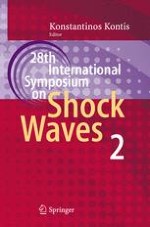2012 | OriginalPaper | Chapter
Starting Flow through Planar Wedged Nozzle: Effect of Nozzle Asymmetry
Authors : Y. Shahack, O. Sadot, A. Britan, G. Ben-Dor, A. Hadjadj, A. Chaudhuri
Published in: 28th International Symposium on Shock Waves
Publisher: Springer Berlin Heidelberg
Activate our intelligent search to find suitable subject content or patents.
Select sections of text to find matching patents with Artificial Intelligence. powered by
Select sections of text to find additional relevant content using AI-assisted search. powered by
The starting process of supersonic planar nozzles has been the subject of great number of the shock tube researches in the past. Initially this was motivated by the need to clearly separate the unsteady and quasi-steady parts of the expansion flow and thus specify the so-called ”test time” period of shock tube tunnels. Among other, the best known images illustrating the starting process were published by Amann [1]. It was clearly shown that the starting flow initiated by the primary shock wave (PS) includes the contact surface (CS) and the secondary shock (SS). Smith [2] was the first to show that the unsteady expansion wave (UEW) which follows the SS can also affect the total duration of the starting flow. Actually, the SS initiates flow separation and transient structure of the separation points (SP). Next, complex phenomenon which requires fundamental knowledge on the parameters of the external flow and the condition inside the boundary layer was discussed by Dussauge & Piponniau [3]. Flow separation may also cause significant effects on the trajectory of the SS and increase the total duration of the starting flow pattern. The renewed interest in nozzle starting phenomena appears due to wide application of the transient nozzle flow in different devices. The effect of separation, for example, becomes important inside the nozzles of rockets, missiles and/or supersonic aircrafts where it is usually undesirable since it may cause a dangerous lateral force which can damage the nozzle [4]. On the other hand, flow separation and the resulting instability of the exit plume could have positive effect when used in high speed mixing devices (Jonson & Papamoschou [5]). Despite a plentiful history and significant progress in the numerical as well as in the experimental investigations, many features of the nozzle starting, flow separation and its asymmetry are still open. Even a brief summary of the involved process clearly shows that the nozzle geometry, the viscous effects and the flow conditions at the entrance and exit are important parameters that must be examined [6]. The current investigation was conducted to evaluate how the nozzle starting process depends on the initial conditions and on the asymmetry of the nozzle installation. In order to assess the role of these factors the incident shock wave Mach number was varied between
M
s
= 1.2 and
M
s
= 1.9 and the nozzle asymmetry was introduced by the relative shifting of half of the nozzle.
